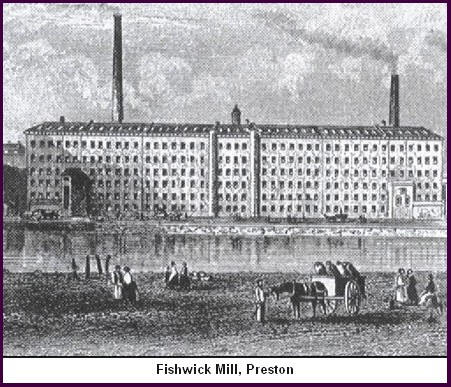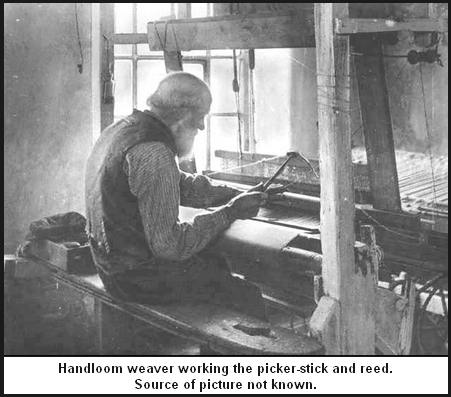Extracts from http://dunkerley-tuson.co.uk , with the kind permission of Philip Dunkerley
Expansion of the cotton industry
In 1793, the year England went to war with
France. France might have been in the throes of a Political Revolution, but
England was experiencing the first years of its Industrial Revolution as the
cotton industry expanded rapidly to become England’s greatest, and sustained,
export earner. Along the River Darwen, south of Preston, from about 1784 several
water mills converted to drive carding and spinning machinery (based on
Arkwright’s water frame and Crompton’s mule)
Preston had been at a serious disadvantage with respect to most other Lancashire
cotton towns in that it neither had running water to power the new spinning
mills, nor was it situated on a coalfield. However there was plenty of coal in
Wigan, fifteen miles to the south, and some had been arriving at Preston from
the middle of the eighteenth century in flat-bottomed barges following
improvement of navigation on the River Douglas. Better transport was needed
though, and in 1792 work began on a canal from Wigan to Preston. By 1803 the
canal was in operation, complete with a substantial tunnel at Whittle le Woods.
A canal crossing of the Ribble Valley proved too expensive however so, instead,
a six-mile tramway was built from Walton Summit to carry the coal down into
Preston. Along this, horse-drawn trains of six wagons, each carrying two-ton
loads, passed on a double-track plate-way.
Preston was eventually to have over 40 mills, and
became one of the major centres for cotton manufacture. Its character as a
genteel market town was completely and irrevocably changed. Other cotton mills
were built south of the River Ribble, notably at Walton-le-Dale and Bamber
Bridge.
The new large spinning mills produced vast quantities of yarn and
presented the mill owners of Preston with the opportunity to create further
wealth by expanding the weaving industry of the area. Surprisingly, the
great advances in cotton spinning were not at first accompanied by any
significant mechanization of the weaving process. Power looms had been tried in
the 1780s, but it was not until about 1806 that a power loom capable of
practical application was developed, and even so, for various reasons, the power
loom was able to displace the handloom weaver only gradually. The annual
consumption of cotton in Britain in the 1780s was 14.8 million pounds, rising to
96.6 million in the 1810s, a more than six-fold increase at a time when
virtually all weaving was still being done by hand. Although machine weaving
began thereafter to increase rapidly, the number of handloom weavers continued
to rise to around 170,000 in the early 1820s before declining gradually to
perhaps 55,000 by the 1850s and to virtual extinction in the 1880s.
 The
Workforce
The
Workforce
The burgeoning demand for handloom weavers from the 1790s was satisfied
from various sources. For one thing, the population of the country in general
rose persistently from about 1740, more rapidly from about 1785, and continued
to rise throughout the nineteenth century. For another, northwest England was
the locus of the highest rates of growth.
Several factors contributed to the increase in population, important among which
were earlier marriages and higher birth rates. Food prices had remained fairly
stable since the 1670s and there was a run of low food prices from 1730 to 1755.
It may have been this fall in the cost of living that permitted the earlier
marriages and therefore produced higher birth rates that set off the population
growth. Lower food prices also meant there was a little more money available for
other purchases, including better clothing, and so helped develop the domestic
market for cotton goods. In the rural area of Penwortham, Hutton and Longton it
would have been relatively easy to set up new looms and train up new cotton
weavers, based on the traditional skills that already existed there in linen
weaving. This pattern of working is very clear in the 1841 census data,
discussed below.
Some, however, of the rising rural population chose to migrate to the nearby
towns where there was a greater demand for labour and the prospect of higher
wages. Besides cotton-working there was much employment to be had in building
the new spinning mills and the rows of brick houses needed for the workers, and
in the associated trades that grew up to support cotton working – engineering,
transport and other services.
Besides the increase in population, other factors also contributed to the rising
industrial labour force. For example, the mechanisation of spinning made the
hand spinners, generally women and children, redundant, freeing some of them up
to work on the loom. In passing, however, we may note that there was still a
need for some women and children to work as ‘bobbin winders’, a tedious activity
essential to keep the weaver supplied with weft for his fly shuttle. Ben
Brierley, a notable Lancashire writer, was only one of innumerable young boys
who felt enslaved by this device, and often mentions how his father would hurl
empty bobbins at his head when he fell behind in replenishing them. One of the
terms of endearment used by his character Ab o’ th’ Yate to describe
his wife is ‘my owd bobbin winder’, and the expression ‘stopped for
bobbins’ was widely used in Lancashire to indicate a hold up in some job or
other.
A further source of new handloom weavers was the demobilised Lancashire soldiers
returning from the Napoleonic wars after 1815 who were desperate to find
employment. As evidenced in a parliamentary paper they commonly ‘exchanged
the musket for the shuttle’. Finally, from about 1800 the influx of Irish
workers, that was to turn to a flood by the time of the potato famine of the
1840s, had already begun.
The Preston area was as short of handloom weavers as many others in Lancashire.
Initially most of the weavers were ‘outworkers’, that is they worked on
traditional four-post looms at home or for a neighbour where they were provided
with yarn for warp and weft either direct from the spinning mills or via
middlemen, and wove lengths of cloth called ‘pieces’ for which they were paid. A
large number of the outworkers lived in the towns and were closely attached to
particular spinning mills that might provide housing. Rows of purpose-built
weavers’ houses, which included a special loom-room partly below ground level,
sprang up in Preston, often crammed as courts into the old medieval town
property boundaries. These houses were small and primitive and later came to
constitute fearful urban slums.
Other outworkers, however, lived outside the towns in rural or village locations
and were serviced from warehouses. Quite a few village communities expanded as a
result of this activity, such as Brindle, near Preston. Often existing houses or
farm buildings were adapted for weaving, but new cottages were also built
specially for the purpose. These might have had a loom-room either on the
ground-floor or as a semi-basement with windows at ground level to provide light
to weave by (see photo). The purpose-built cottages sometimes had space for
several looms, typically four, so that several members of the family, or
neighbours, could find useful employment, and they often had earth floors to
help maintain the high humidity that kept the cotton fibres soft and pliable.
The 1790s were boom times when the so-called modern idea of ‘working from home’
was actually widely achieved across Lancashire.
By 1816 the impact of the Horrocks mills on the villages was huge – they
employed 'a whole countryside of weavers, 7,000 in all' and other
local spinning firms must also have employed outwork handloom weavers. Thus the
scattered country weavers in villages such as Penwortham, Hutton and Longton
were integrated via putters-out into the weaving network, and indeed by 1791
John Horrocks himself had established a warehouse in Longton supplying weavers
with yarn and receiving the finished cloth. Joseph Livesey (born at
Walton-Le-Dale in 1794) was to say in his autobiography that ‘in the country
around Preston all the small farms in Walton, Penwortham and the adjoining
country places were ‘weaving farms’, having a ‘shop’ attached to hold a certain
number of looms'.
The Town Labourer
In the countryside, where village life still retained much of the
village structure, food might be grown and there was a family network that might
provide some support. However, even if only in passing, it should be noted that
the lot of the industrial worker who cut his links with the land deteriorated
badly from the late 1790s.
For one thing, labour in the spinning mills was often twelve or more
hours per day for five or six days a week. However, the Horrocks concerns
employed ten times as many weavers as spinners, and almost
from the start the conditions in which many of them were housed in Preston were,
to say the least, awful. Even as early as 1791 a writer told of the pull of
Preston on the inhabitants of the surrounding area, where they were tempted by
the prospect of ‘good wages at what they think easy work’ but then
found that they had to work in filthy, overcrowded conditions, paying high
prices for food and rents. In the autumn and winter they ended up on a poor diet
and were prone to ‘low and nervous fevers; in short, putrid and gaol
distempers, that often cut off men, leaving families behind’.
The years of the French Wars (1793-1815) were generally difficult for trade,
with wild fluctuations in food prices, availability of work, and declining piece
rates, and the following years saw the power loom continuously make inroads into
the ranks of the handloom weavers. In 1826 there were riots in which power looms
were smashed. There was a lengthy – but failed – strike in Preston in 1836, and
hunger stalked the town in 1841-2 at the time of the ‘Plug Riots’ when four men
were killed. It was not until 1844 that legislation restricted the daily total
of hours worked to twelve. Once the industrial worker lost his connection with
the land he had only his labour to fall back on and at times of poor markets
there certainly was awful hardship in many cases.